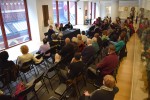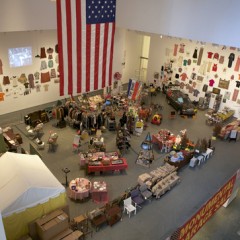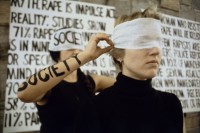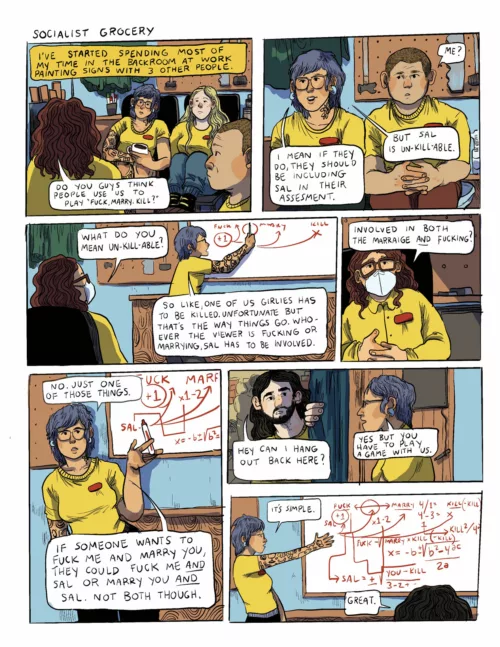My son Max and I went to the College Art Association‘s session on copyright on Friday. “Reexamining Appropriation: The Copy, The Law, and Beyond, Part 1” was held at the New York City Bar Association, and included on the panel were Judge Pierre N. Leval of the US Court of Appeals for the Second Circuit and William Patry, Google’s copyright law expert (he’s also a
blogger!) and three art historians, Lisa Pon (Meadows School of the Arts, SMU), Johanna Burton (Princeton) and Jaimey Hamilton (U of Hawaii).
I took copious — although, as it turns out, a little spotty — notes and have distilled them below.
Session Co-chair Virginia Rutledge of Cravath, Swaine & Moore LLP led off with a broad discussion that began with a mention of the Whitney’s “Image World” exhibit. (read Michael Kimmelman’s grumpy review of the show in which he complains mightily about the curating and the catalog essays and says very little about the work).
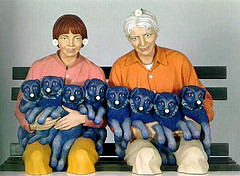
Jeff Koons’s String of Puppies based on a postcard photo by Art Rogers.
Some argue that appropriation is theft, she stated…but then you might say that art is an open source project and that all artists borrow. In fact Jeff Koons used this argument to defend himself in the 1992 court case Art Rogers v. Jeff Koons.
Oliver Wendel Holmes defined art as a copy of the world which is real.
Now with changing technology (second life etal) what is a copy and what is real become all the more cloudy. Jeff Koons, who lost one case of copyright has won another (picture below is the second, winning copyright case involving Koons)
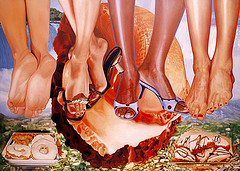
Jeff Koons, Niagara, 2000. Oil on canvas, 120 x 172 inches. Deutsche Guggenheim.
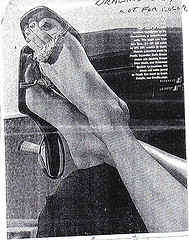
Allure magazine photo appropriated by Koons. The photographer sued and Koons won this one.
In Blanch v. Koons, No. 03 Civ. 8026 (LLS), S.D.N.Y., Nov. 1 2005 (slip op.), [3], affirmed by the Second Circuit in October, 2006, brought over his use of a photographic advertisement as source material for legs and feet in a painting, Niagara (2000). The court ruled that Koons had sufficiently transformed the original advertisement so as to qualify as a fair use.
Lisa Pon
Inappropriate? Copying in the Rennaissance
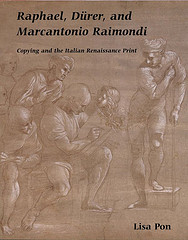
Lisa Pon’s book, Raphael, Dürer, and Marcantonio Raimondi: Copying and the Italian Renaissance Print was published in 2004 by Yale University Press
Back in the Renaissance, imitation was considered the way to learn. “The more closely we imitate real poets the better we write” said Dante. Vasari said you don’t need to invent anymore because Michelangelo has done it all. Artists should just copy him! (Vasari followed his own advice and copied motifs from the master in his own works).
Michelangelo in fact shared information with Raphael. But later Michelangelo was not happy, complaining that “everything Raphael got about art he got from me.” But it never went to a court of law.
There was no copyright in the Renaissance. Texts and narratives were not seen as authored. They were in the public domain except when privileged (ie when the creator petitioned for the privilege of ownership–and this was granted for a specific short time and in a specific geographical location).
The case of Durer and Raimondi
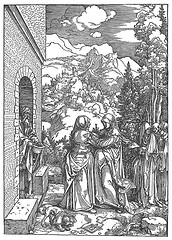
Albrecht Durer, The Visitation, woodcut, from The Life of the Virgin
Here’s a tale from Giorgio Vasari‘s The lives of the artists.
Whether it is factually true or not is unclear because Vasari may have changed the truth to illustrate a point. Marcantonio Raimondi made copies of Durer’s prints. He copied everything even Durer’s distinct signature. The prints were bought and sold as Durer prints. Durer complained in Venice. And Raimundi had to take Durer’s name off. Then Durer made a book of his prints on the Virgin mary that included a diatribe against copiers. The case is a watershed in authorship of images. And Raimondi made prints with his own signature on it as well as Durer’s and his publisher’s.
Here’s a link to an image of Raimondi’s that’s identical to Durer’s including Durer’s signature.
This collision between authorial output and old style copying without the idea of authorship was new. Raimondi functioned in a religious economy where copying of religious images and distributing them for worship was ok.
Johanna Burton
The Reign of the Quotation-Appropriation and its audience
[This is where my notes fail me. Burton’s paper was packed with references to theory and her presentation was harmed by her reading the text instead of distilling it into succinct digestible points. Much was made of Sherrie Levine’s appropriations. And there was a long critique of Jonathan Lethem’s article on plagiarism in this month’s Harpers. There were suggestions that Letham’s argument involved some sexism (he only mentioned men artists.) Feminism came up as did communism; and the notion of the guest; the role of the audience and something called the public commons, which, I believe, came from Lethem but again, I’m not sure.) The presentation seemed overly long and the argument was amorphous and somehow the salient points, hidden, coded in art theory, were lost on me.]
Jaimey Hamilton
Appropriation v. Piracy, round Two?
Appropriation is a word to avoid said the Tate Modern Curator of the 2006 Triennial, a show devoted to repetition and reprocessing of imagery in today’s art.
The word appropriation is too loaded with Duchampian baggage.
We live in a file sharing culture where post-production is not a problem. Richard Prince, Barbara Kruger etal have been absorbed by the market. Sampling is a metaphor for our culture. Dubois spoke of a double consciousness. Now there’s only one consciousness.
(Here she mentions 3 samples of sampling:)
Paul Pfeiffer’s appropriations: He changes the spectacle into something else.
Douglas Gordon and Philippe Parreno’s Zidane which plays with the penetration of identity (David Beckham) in the digital realm. the 90 minute film debuted in Cannes and went to film festivals. It’s art but it’s inside the pop culture.
Pierre Huyghe and Parreno bought the copyright of a manga character, AnnLee, and then got others to develop her character and insert her in stories. One Million Kingdoms is the project.

One Million Kingdoms, 2001. Video installation with sound, 00:07:00, Edition 5/6, dimensions vary with installation. Solomon R. Guggenheim Museum
We’re on the verge of web 2.0 with open source a part of the culture. everything is available on my space, you tube etc. Post production is more casual, especially for the young. Corey Arcangel hacked Super Mario Brothers game to make art that was shown at the Whitney Biennial. He also has a DIY website where he shows you how to do things.
Copilandia, Federico Guzmán and Kirby Gookin invite visitors to appropriate — literally on a boat with art-making materials and no copyright laws to restrain them.
They place the viewer in a new empowerment and give them tools. What is property? Artists are asking us to reframe commodity culture making the process visible. It’s good for debate.
…….
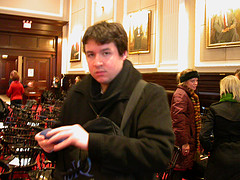
Max, after the panel.
The first thing Max, who spends pretty much every waking hour sitting in a chair at the computer doing either his web comic or online patent searches for his job, said after getting up from the 2 hour and 30 minute panel discussion: “These are the most uncomfortable chairs in the world!” They were indeed. But we both thought the panel was great.
Max is going to law school next year and hopes to specialize in copyright,a topic that will continue to give lawyers and judges work as long as there are artists out there and art matter to be appropriated and copied.
[Ed Note: Because this post is so long, I’ve removed a portion of it and stored it elsewhere online. You can read the whole post by downloading the word doc.]


